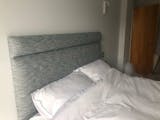It can be tempting to lay a mattress on top of another one in an attempt to increase comfort, sleeping height or just because you can’t bring yourself to throw the older one out just yet! If you’re short on space, you may even stack mattresses while you decide what to do with one.
Can you put a mattress on top of another mattress?
We often get asked can you put another mattress on top of another mattress. The answer is, you’ll probably only end up wrecking both mattresses, invalidating your warranty and increasing the risk of harbouring allergens and other nasties within your bed. Plus, the top one could slowly slide off if you move around a lot in your sleep.
There are better solutions to increasing firmness, softness and raising your bed higher. Here are the main reasons why stacking two or even three mattresses on top of each other isn’t a very good idea.
It will damage the mattresses
When you place mattresses on top of each other, the overall structure becomes unstable. The bottom mattress will probably be supporting more weight than it was designed to. Regardless, the downward pressure will slowly crush the mattress beneath, rendering it unusable after a period of time.
The mattress on top won't fare much better in the long run either. Indentations, depressions and dips will form, particularly if it’s a memory foam mattress.
If you have a bed with slats, the extra weight will lead to the bottom mattress sagging between the gaps. Over time, the top one will invariably develop bulges on its bottom in the same places. Even if you added extra slats in a bid to beat the bulge, the bed will sag at the edges of the frame.
Your mattress needs a strong and sturdy foundation
A mattress needs to lie upon a proper foundation. When used normally, this will be a steel or wooden bed frame with slats or a solid upper layer in a divan bed.
If you think that stacking one mattress on top of another will provide a sturdy base, it won’t. You’d be better putting the mattress on the floor than one on top of the other. That would at least offer a solid foundation.
Mattress stacks will move and slip
A mattress on top of a mattress will naturally wobble. All that clambering on and off, turning over when you’re asleep and any other motion will begin to move your mattresses.
The border area of mattresses tend not to be flat and will dip in the millimetres before the stitching of the rod edges. Many mattress tickings (covers) are made from shiny, silky materials, which will only add to the slippage between the layers.
The worst that will probably happen is that you’ll have to shunt the mattresses back level with each other every day. All that movement will compromise the structure of the mattress. If they have internal coil springs, they will become warped and could fail. You could end up on the floor if the top falls off the bottom too.

It can increase back pain and other discomfort
Modern mattresses aren’t merely cosy slabs on which to rest; they’re designed and engineered with ergonomics and posture firmly in mind, backed by sleep science and research.
Posture and positioning in bed play a big part in how comfortable your night’s sleep will be. Laying a mattress on top of another changes the structure, either from the continued weight on points that were not designed to take weight or because the materials are breaking down. This alters the way the mattress supports your body and can cause muscular discomfort and pain.
A mattress needs to breathe
A mattress is designed so that air flows through its layers to keep it ‘aired’ and maintain structural integrity. The bottom of a mattress accounts for approaching half of its overall surface area. Preventing air entry and airflow on such a large part is not how the mattress was designed to perform - moisture and heat will build up, which causes performance and other issues.
You’ll get even hotter in bed
Memory foam mattresses retain heat. Bodyheat actually triggers a memory foam mattress to adjust to your body shape. The molecules in the memory foam reconfigure under pressure, aided by warmth.
If the mattress is on top of another one, then more heat than was intended is trapped within it, and the additional mass changes the aerated layers. This will lead to overheating in bed.
It can trigger allergies
Hypoallergenic covers are designed to reduce the presence of allergens such as dust mites in mattresses. If the bottom layer of covering is trapped on top of another mattress, it reduces the effectiveness. The build-up of heat and moisture aided by stacking mattresses also leads to mould formation.
It will void the warranty
As with any warranty, mattresses are protected by the policy if they are used as the manufacturer intended. Stacking mattresses is not that. A warranty will often state that the mattress should be placed on a bed frame and can even assume that the correct type of slats and their spacing will be applied; otherwise, the warranty would be void.
What is a better alternative to mattresses stacked on top of each other?
If you’ve got two mattresses that are past their best and you’re tempted to stack them to increase comfort, it’s a definite sign you need a new mattress altogether. If that is beyond your budget, a stop-gap would be to purchase a foam mattress topper for improved comfort. Don’t be tempted to stack mattress toppers though as they will almost certainly lack the support needed for a comfortable night’s sleep.
Ultimately, your best bet is to buy a new mattress. If your old one is more than ten years old, you might be surprised at how far mattress technology has progressed in recent years.
Check out our range of bespoke mattresses to pick the one that best suits your sleep style and preferences. The investment will pay you back with thousands of comfortable night’s sleep long into the future.







